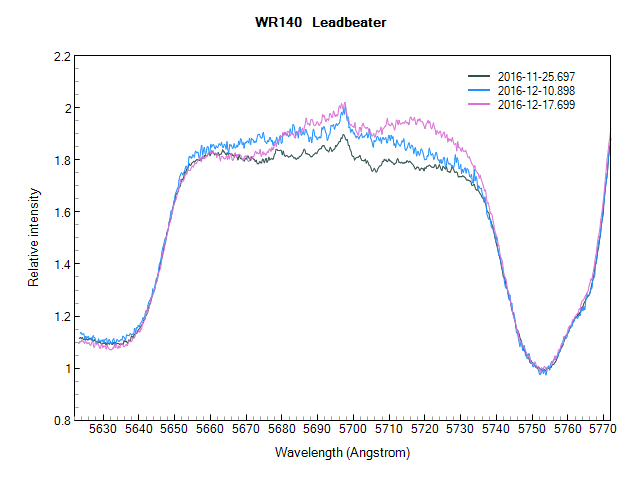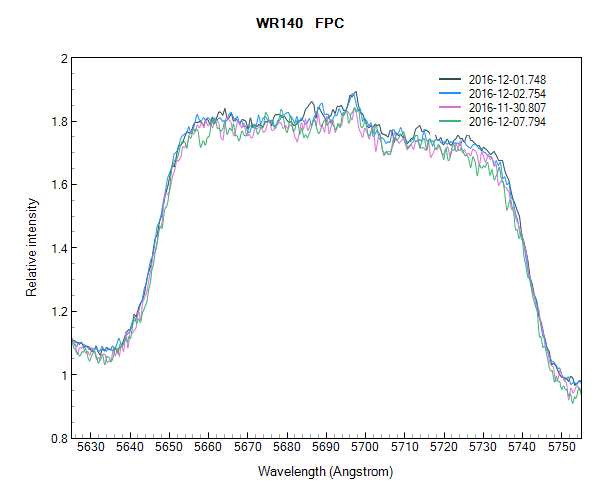Page 3 of 5
Re: WR140 aproaching periastron
Posted: Wed Dec 14, 2016 12:52 pm
by Paolo Berardi
Hi all, congratulations for you spectra! Joan, the comparison for 30 november is impressive... so the spectrographs really works!

Changes in the CIII line between 23 nov and 12 dec:

Paolo
Re: WR140 aproaching periastron
Posted: Sun Dec 18, 2016 8:05 pm
by Paolo Berardi
Colliding winds effect on the CIII line is more pronounced now (green profile is the just finished observation).

Paolo
Re: WR140 aproaching periastron
Posted: Mon Dec 19, 2016 1:36 pm
by Robin Leadbeater
Tony Moffat, the professional coordinating this campaign has asked anyone who is following WR140 through periastron to contact him
http://forum.vdsastro.de/viewtopic.php?t=4575#p28564
Cheers
Robin
Re: WR140 aproaching periastron
Posted: Mon Dec 19, 2016 2:06 pm
by Robin Leadbeater
My latest spectra (more noisy recently because of poor weather)

- WR140_Three_Hills_Observatory.png (33.78 KiB) Viewed 8564 times
Cheers
Robin
Re: WR140 aproaching periastron
Posted: Tue Dec 20, 2016 4:26 pm
by Tim Lester
WR140 for Dec 19th compared to my last exposure on Nov 5th.
Took three sets of 3x10 min exposures. No discernible change over the three sets.
Tim
Re: WR140 aproaching periastron
Posted: Wed Dec 21, 2016 10:16 pm
by Paolo Berardi
Hi all!
I've contacted prof. Moffat, sending my spectra. From my observing site I have some high obstacles toward west horizon, so at first I thought that I wouldn't be able to produce useful observations. This is why I did not ask to join the campaign. I realize that I should be able to continue observations til January (I hope).
Tim, I also run a check for any profile changes that can happen during the session using PlotSpectra: I load every sub-exposures frame profile (@pro ISIS intermediate files). Very quick and useful!

Paolo
Re: WR140 aproaching periastron
Posted: Fri Dec 23, 2016 10:27 pm
by Francisco Campos
Hello,
very nice all the spectra published.
I tried to reduce my spectra but I'm doing something bad. As you see, there is a strong dispersion between the spectra except at the lambda utilised to normalize them. All spectra are corrected in response using HIP 99870.
I tried also to compare all spectra with a well corrected pattern but these differences remain. What is very curious is: why when I find the instrumental response in low-resolution spectra and correct the comparison star, the corrected spectrum matchs exactly the library's spectrum, but when working at medium-resolution this one doesn't happens. Maybe have I something bad-configured in ISIS?
Anyway, after a couple of days without observing (bad weather and other problems), tonight I resume the monitoring of WR140, but I need to know how to erase these deviations at high lambda...
Greetings
Fran

- wr140_ 20161201_748_FPC sub.png (39.14 KiB) Viewed 8506 times
Re: WR140 aproaching periastron
Posted: Sat Dec 24, 2016 12:06 pm
by Robin Leadbeater
Hi Fran,
That is strange. How much does your instrument response vary? I do not think the instrument response changes much between observations at this wavelength and over this short range. How do the spectra compare if you reduce them without instrument response correction ?
Cheers
Robin
Re: WR140 aproaching periastron
Posted: Mon Dec 26, 2016 9:25 pm
by James Foster
Here is my chart for activity for WR140 17-25Dec2016.

My 17Dec16 data was taking under cloudy/under-exposed conditions and
is barely usable. Hope someone gets good data for this quickly descending
object in central Cygnus!
James Foster
Los Angeles, CA
Re: WR140 aproaching periastron
Posted: Tue Dec 27, 2016 1:54 pm
by Olivier GARDE
Some comparisons between 4 spectra taken in december: 3 before the periastron, 1 after (the 25th) with an eshel spectrograph.
With the eshel, the most difficulty is to merge the spectra of several orders in order to have the full width of the band CIII-CIV and a good continnuum specially at each end of each order.
Difficult also with the weather not so find in the south est of France actually, (not a really clear sky)
Here's a result first with 3 orders merge (order #40, #39 and #38)

And another with only #39 order

The last spectrum (in red) taken the 25th show an evolution with others spectra taken before the periastron.







